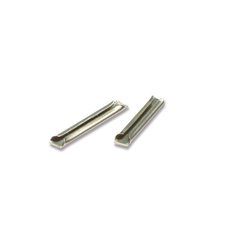You'll likely have come across the term "NEM pockets" when delving into the world of model railway couplers. But what...
No products
Product successfully added to your shopping cart
There are 0 items in your cart. There is 1 item in your cart.
Search Tips
Why do rail joiners and fishplates fail after time?
For those not in the know, rail joiners are the little metal clips (sometimes referred to as fishplates) that connect sections of model railway track together. Specifically, it's the metal rail part of the track section that slides into the rail joiner and, when connected, performs two functions. Firstly, the rail joiner keeps the two sections of track together and secondly, it ensures electrical continuity from one section of track to the next, but after time they can become unreliable.
There are two ways in which rail joiners fail, often they can become loose, especially if the track is taken apart and put together frequently. The reason for this is fairly obvious as the rail joiners gradually lose their shape and don't grip the opposing rail as well as they did when new. This will result in a loss of adhesion and electrical contact. But what about those that have never lifted their tracks and have even glued them down? Then one day they simply stop conducting the current and dead spots start appearing all over the layout.
This is likely due to oxidisation and corrosion. Metal rails and the rail joiners themselves will react to air and moisture. As tight as you may think your rail joiners were on the day your track was laid, there would always have been minute spaces small enough to not feel or notice but large enough for air or moisture to find a way in. This effect would have been greatly accelerated if your tracks received a good dowsing of water to apply a PVA solution to the ballast.
But sometimes air and natural room humidity can wangle their mischievous way into our rail joiners even without provocation from us modellers in pursuit of the perfect ballast, and it's all thanks to temperature variations (especially in lofts or garages). As in real life, rails expand when they get hot and contract when they're cooler, this creates all the movement joiners need to gradually wiggle loose and let air in.
One solution to this problem is to apply a spot of solder on your rail joiners when laying your track. This will provide an airtight electrical connection that will not allow oxidisation to take place. Another good practice is to install a bus-wire connecting power to multiple locations around your layout. Not only will this help compensate for any dodgy rail joiners, but it will also combat voltage-drop on larger layouts which is where current loses its oomph over long distances.
At the end of the day, the more things you can do to combat oxidisation the better your trains will run, and for longer.
Click here to receive the tips weekly in your mailbox. You can unsubscribe at any time.










